Search Result
Results for "
biotin derivative
" in MedChemExpress (MCE) Product Catalog:
9
Biochemical Assay Reagents
| Cat. No. |
Product Name |
Target |
Research Areas |
Chemical Structure |
-
- HY-128699
-
|
Dethiobiotin
|
Endogenous Metabolite
|
Others
|
|
D-Desthiobiotin is a biotin derivative used in affinity chromatography and protein chromatography. D-Desthiobiotin also can be used for protein and cell labeling, detection and isolation .
|
-
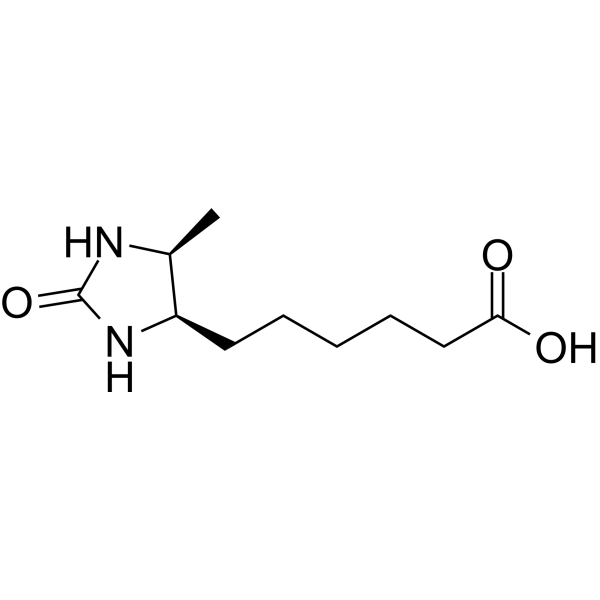
-
- HY-151714
-
|
|
ADC Linker
|
Others
|
|
Biotin-MeTz shiyi is a click chemistry reagent with a terminal methyltetrazine group. Biotin-MeTz shiyi, as a biotin derivative, can be used for the preparation of biotinylated conjugates .
|
-
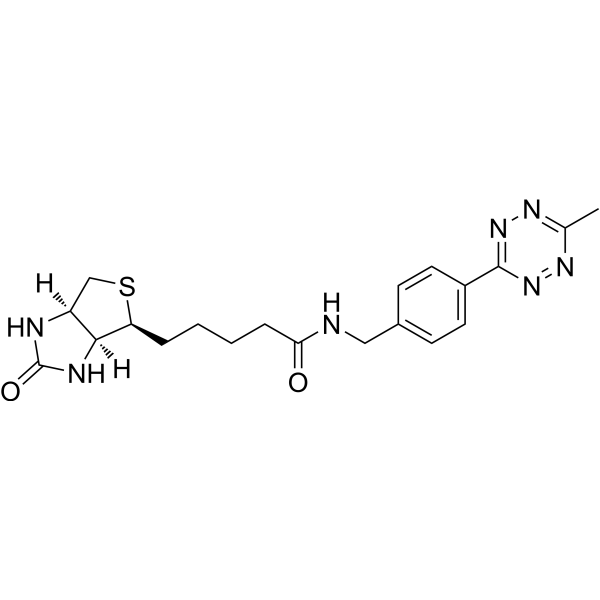
-
- HY-D1695
-
-
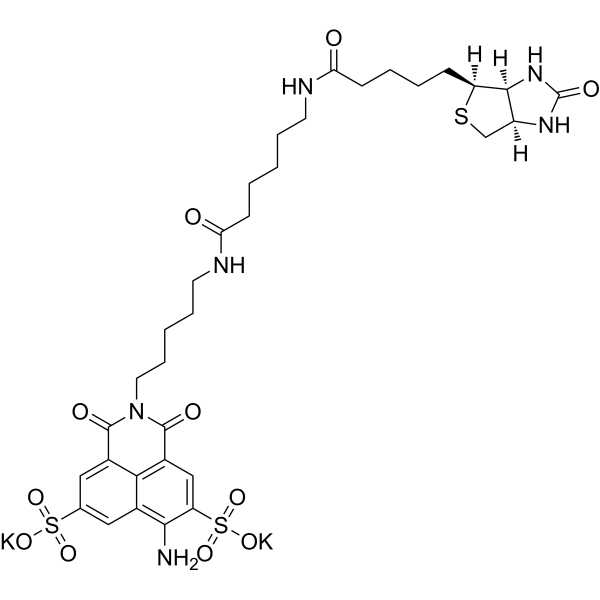
-
- HY-140946
-
|
|
Fluorescent Dye
|
Others
|
|
TAMRA-PEG3-biotin is a dye derivative of TAMRA (HY-135640) containing 3 PEG units. TAMRA-PEG3-biotin is tagged with biotin.
|
-
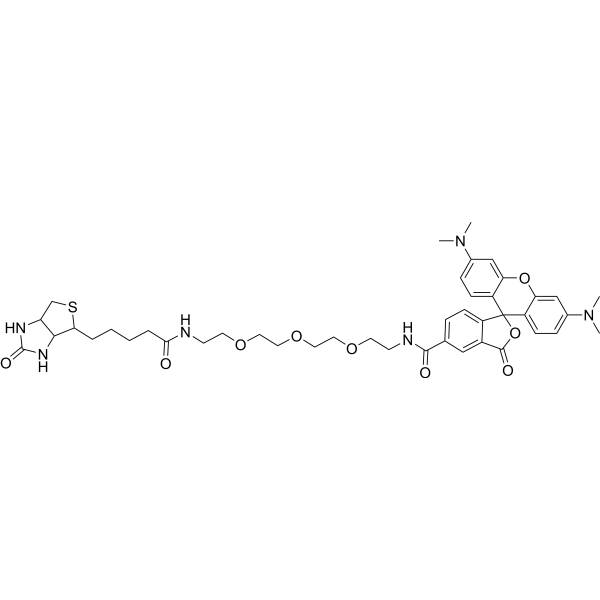
-
- HY-140656F
-
|
|
Fluorescent Dye
|
Others
|
|
Biotin-PEG-Biotin (MW 20000) is a biotin labeled PEG derivative. Biotin is an enzyme co-factor, can be used for labeling protein; PEG is a hydrophilic and water-soluble polymer with low toxicity.
|
-
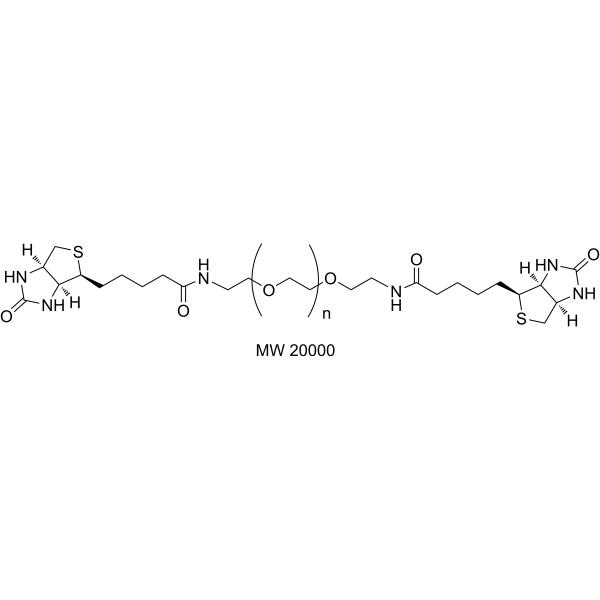
-
- HY-D1938
-
|
|
Fluorescent Dye
|
Others
|
|
ATTO 465 Biotin is a biotin derivative of ATTO 465 with maximum excitation/emission wavelengths: 453/506 nm.
|
-

-
- HY-D1942
-
|
|
Fluorescent Dye
|
Others
|
|
ATTO 590 Biotin is a biotin derivative of ATTO 590 with maximum excitation/emission wavelengths: 594/622 nm.
|
-
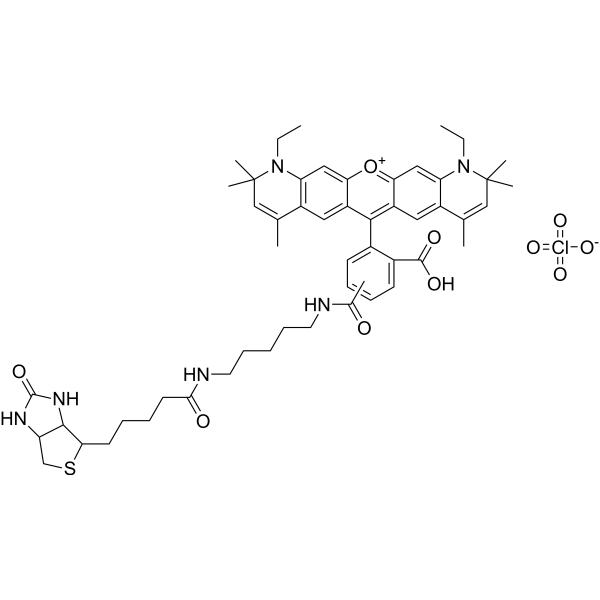
-
- HY-D1951
-
|
|
Fluorescent Dye
|
Others
|
|
ATTO 594 Biotin is a biotin derivative of ATTO 594 with maximum excitation/emission wavelengths: 603/626 nm.
|
-
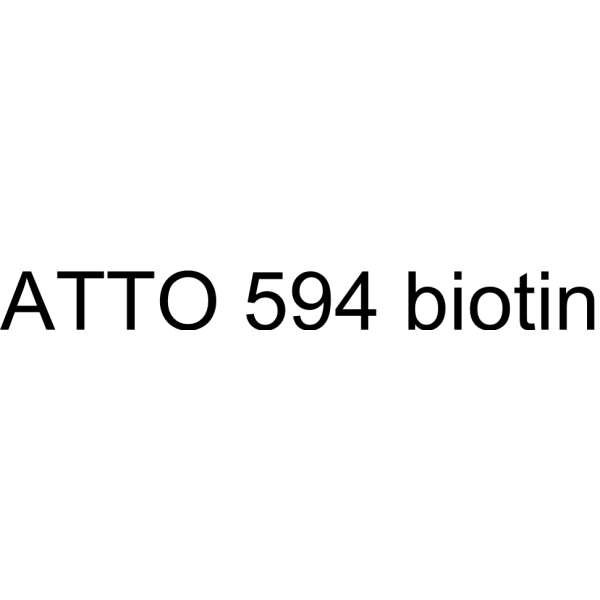
-
- HY-D1964
-
|
|
Fluorescent Dye
|
Others
|
|
ATTO 633 Biotin is a biotin derivative of ATTO 633 with maximum excitation/emission wavelengths: 630/651 nm.
|
-
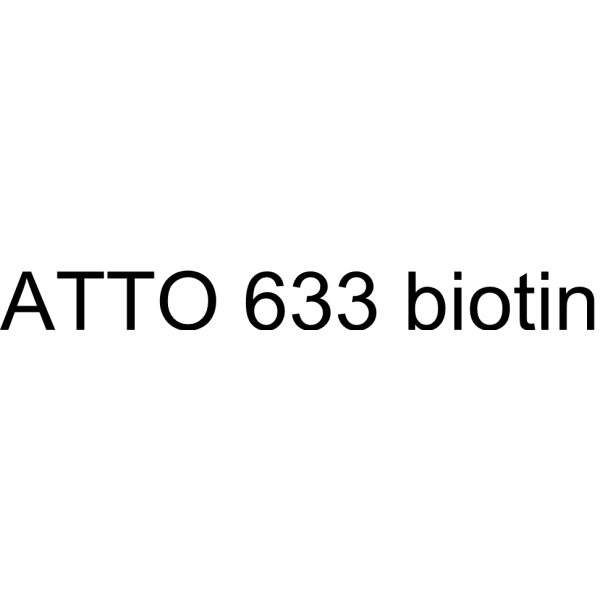
-
- HY-D1965
-
|
|
Fluorescent Dye
|
Others
|
|
ATTO 700 Biotin is a biotin derivative of ATTO 700 with maximum excitation/emission wavelengths: 700/716 nm.
|
-
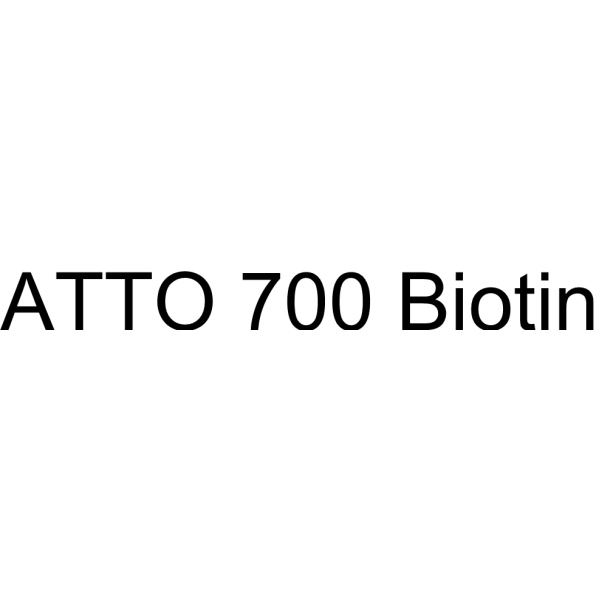
-
- HY-D1978
-
|
|
Fluorescent Dye
|
Others
|
|
ATTO 610 Biotin is a biotin derivative of ATTO 610 with maximum excitation/emission wavelengths: 616/633 nm.
|
-

-
- HY-D1988
-
|
|
Fluorescent Dye
|
Others
|
|
ATTO 620 Biotin is a biotin derivative of ATTO 620 with maximum excitation/emission wavelengths: 620/642 nm.
|
-

-
- HY-D1989
-
|
|
Fluorescent Dye
|
Others
|
|
ATTO 725 Biotin is a biotin derivative of ATTO 725 with maximum excitation/emission wavelengths: 728/751 nm.
|
-
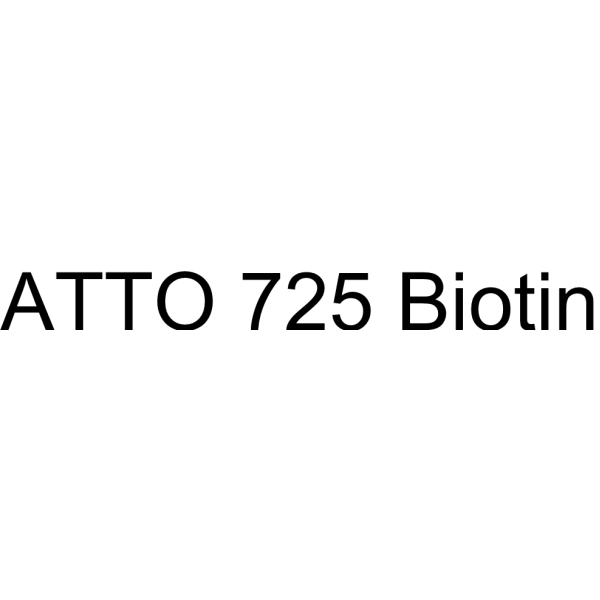
-
- HY-D1996
-
|
|
Fluorescent Dye
|
Others
|
|
ATTO 647 Biotin is a biotin derivative of ATTO 647 with maximum excitation/emission wavelengths: 630/651 nm.
|
-

-
- HY-D2003
-
|
|
Fluorescent Dye
|
Others
|
|
ATTO 565 biotin is a biotin derivative of ATTO 565 with maximum excitation/emission wavelengths: 564/590 nm.
|
-
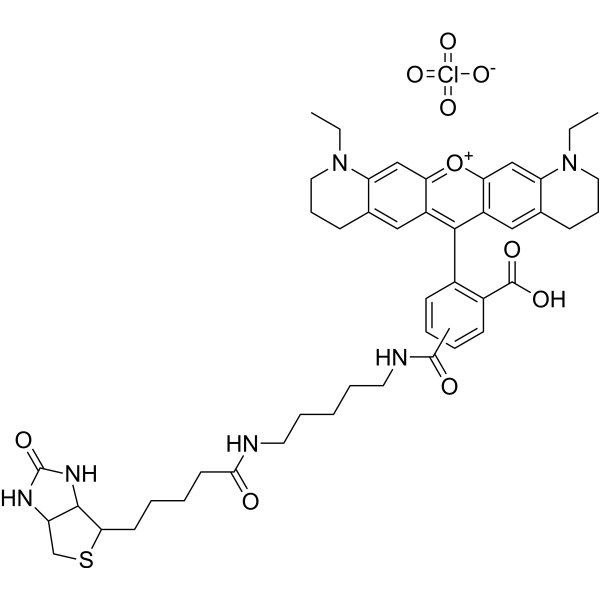
-
- HY-D2007
-
|
|
Fluorescent Dye
|
Others
|
|
ATTO 488 biotin is a biotin derivative of ATTO 488 with maximum excitation/emission wavelengths: 500/520 nm.
|
-

-
- HY-D2025
-
|
|
Fluorescent Dye
|
Others
|
|
ATTO 550 biotin is a biotin derivative of ATTO 550 with maximum excitation/emission wavelengths: 554/576 nm.
|
-
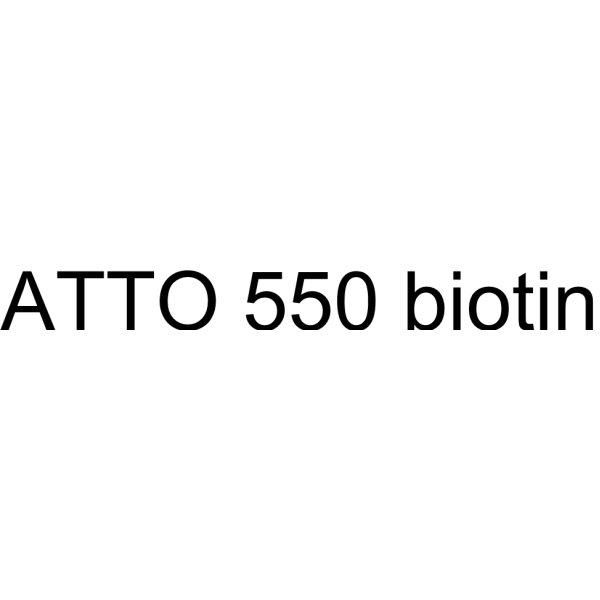
-
- HY-D2076
-
|
|
Fluorescent Dye
|
Others
|
|
ATTO 740 biotin is a biotin derivative of ATTO 740 with maximum excitation/emission wavelengths: 743/763 nm.
|
-
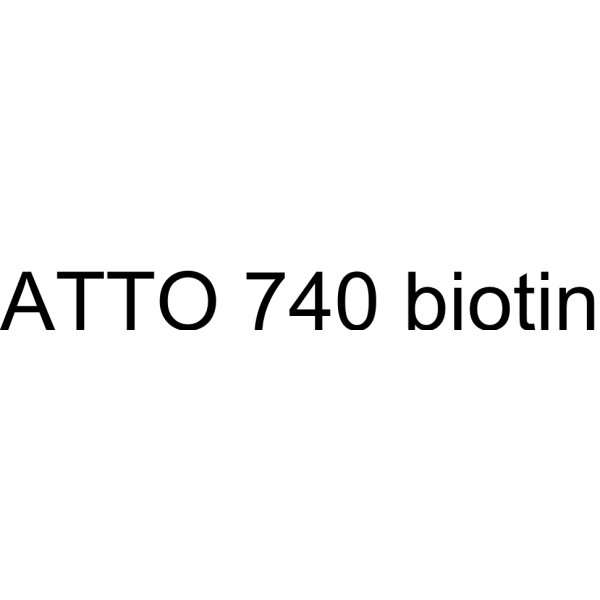
-
- HY-D2031
-
|
|
Fluorescent Dye
|
Others
|
|
ATTO 514 biotin is a biotin derivative of ATTO 514 with maximum excitation/emission wavelengths: 511/531 nm.
|
-
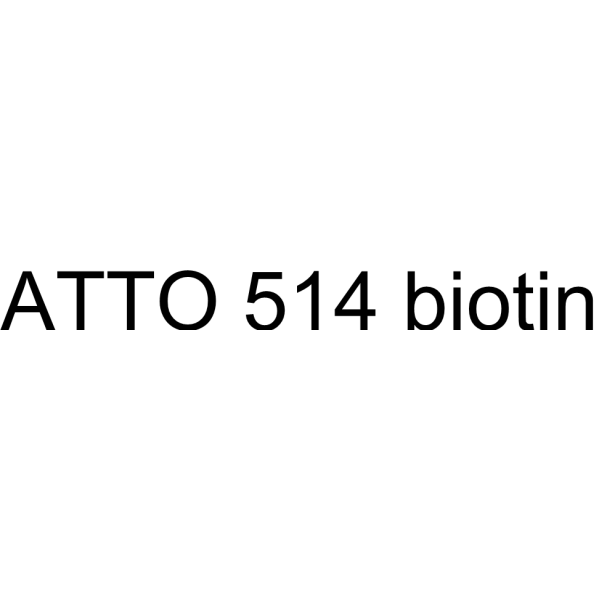
-
- HY-D2049
-
|
|
Fluorescent Dye
|
Others
|
|
ATTO 532 biotin is a biotin derivative of ATTO 532 with maximum excitation/emission wavelengths: 532/552 nm.
|
-
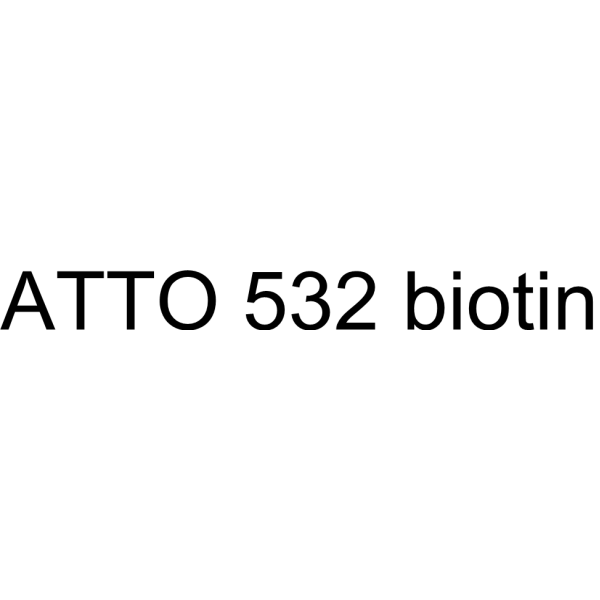
-
- HY-D1911
-
|
|
Fluorescent Dye
|
Others
|
|
ATTO 665 Biotin is a biotin derivative of ATTO 665 with maximum excitation/emission wavelengths: 663/680 nm.
|
-
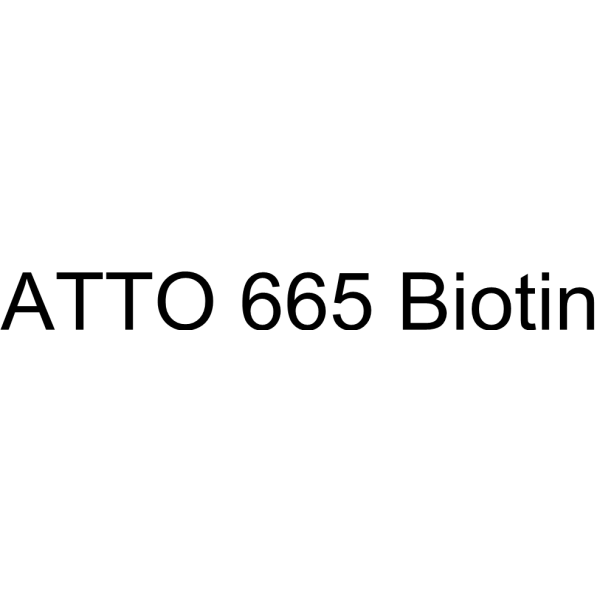
-
- HY-D2065
-
|
|
Fluorescent Dye
|
Others
|
|
ATTO 680 biotin is a biotin derivative of ATTO 680 with maximum excitation/emission wavelengths: 681/698 nm.
|
-
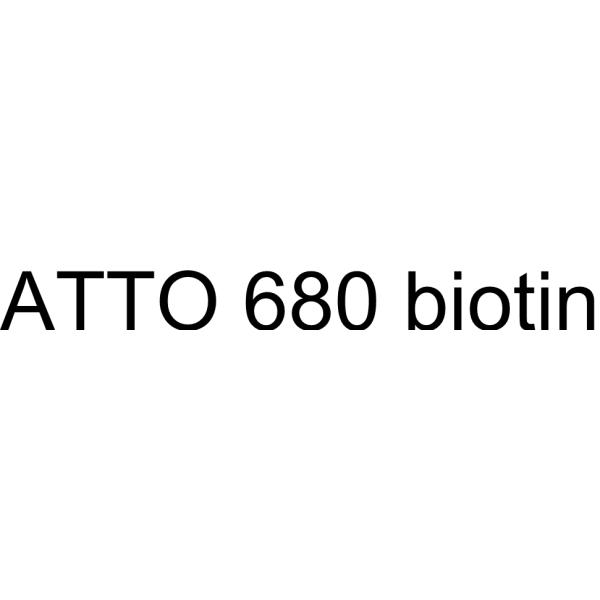
-
- HY-D1923
-
|
|
Fluorescent Dye
|
Others
|
|
ATTO 390 biotin is a biotin derivative of ATTO 390, used for streptavidin reaction, maximum excitation/emission wavelength: 390/476 nm.
|
-
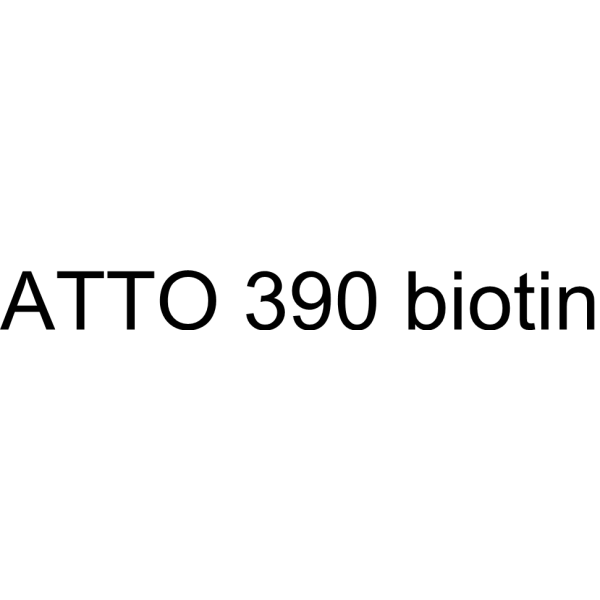
-
- HY-D1927
-
|
|
Fluorescent Dye
|
Others
|
|
ATTO 425 Biotin is a biotin derivative of ATTO 425, used for streptavidin reaction, the maximum excitation emission wavelength: 439/489 nm.
|
-
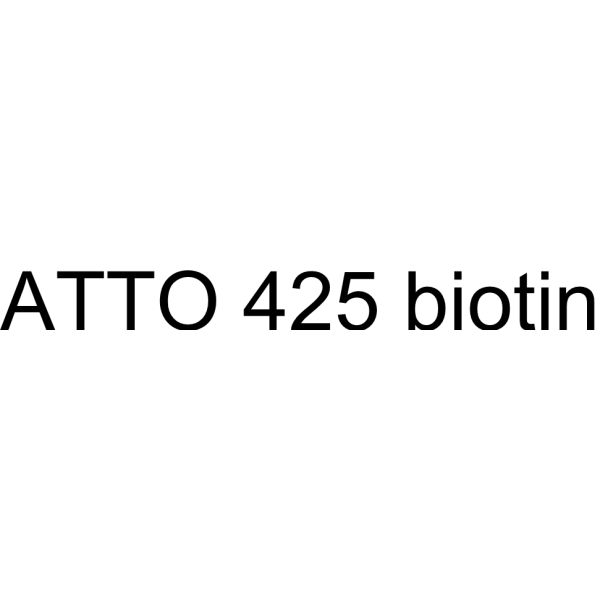
-
- HY-W010721
-
-

-
- HY-130809
-
|
|
Biochemical Assay Reagents
|
Cancer
|
|
DBCO-PEG4-Biotin is an azadibenzocyclooctyne-biotin derivative containing a biotin group and 4 PEGs. DBCO-PEG4-Biotin is a versatile biotinylation reagent used for the introduction of a biotin moiety to azide-labeled biomolecules via copper-free strain-promoted alkyne-azide click chemistry (SPAAC) reaction . DBCO-PEG4-Biotin is a click chemistry reagent, it contains a DBCO group that can undergo strain-promoted alkyne-azide cycloaddition (SPAAC) with molecules containing Azide groups.
|
-
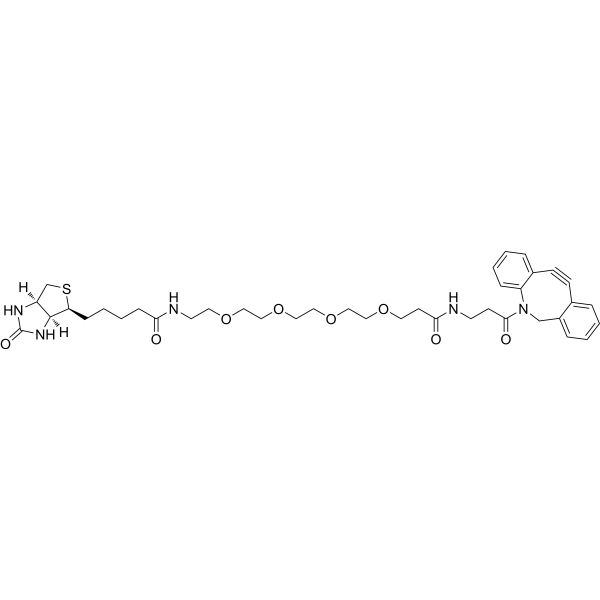
-
- HY-W250928C
-
|
Carbamic acid, N-(17-azido-3,6,9,12,15-pentaoxaheptadec-1-yl)-, 1,1-dimethylethyl ester
|
Fluorescent Dye
|
Others
|
|
Biotin-PEG-azide (MW 2000) is a biotin labeled PEG derivative. Biotin is an enzyme co-factor, can be used for labeling protein; PEG is a hydrophilic and water-soluble polymer with low toxicity; azide, is a moderately good leaving group, can react with alkyne by Cu-catalyzation, which improve the efficiency of biotin binding targets.
|
-
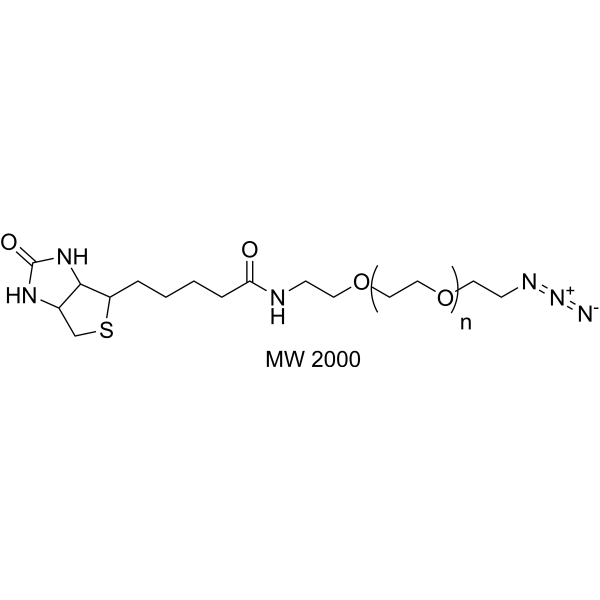
-
- HY-W250928D
-
|
Carbamic acid, N-(17-azido-3,6,9,12,15-pentaoxaheptadec-1-yl)-, 1,1-dimethylethyl ester
|
Fluorescent Dye
|
Others
|
|
Biotin-PEG-azide (MW 3400) is a biotin labeled PEG derivative. Biotin is an enzyme co-factor, can be used for labeling protein; PEG is a hydrophilic and water-soluble polymer with low toxicity; azide, is a moderately good leaving group, can react with alkyne by Cu-catalyzation, which improve the efficiency of biotin binding targets.
|
-
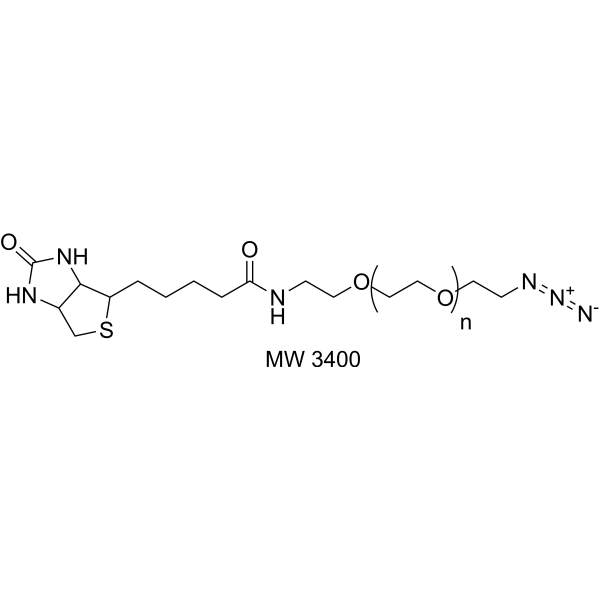
-
- HY-147207
-
|
|
Liposome
|
Others
|
|
Phospholipid-PEG-Biotin (MW 1000) is a phospholipid PEG derivative that has a biotin and a phospholipid bridged by a linear PEG linker. Phospholipid-PEG-Biotin (MW 3400) can interact with avidinylated antibodies. Phospholipid-PEG-Biotin (MW 3400) can be used to modify liposome and cells surface, and pancreatic islets for cell transplantation .
|
-
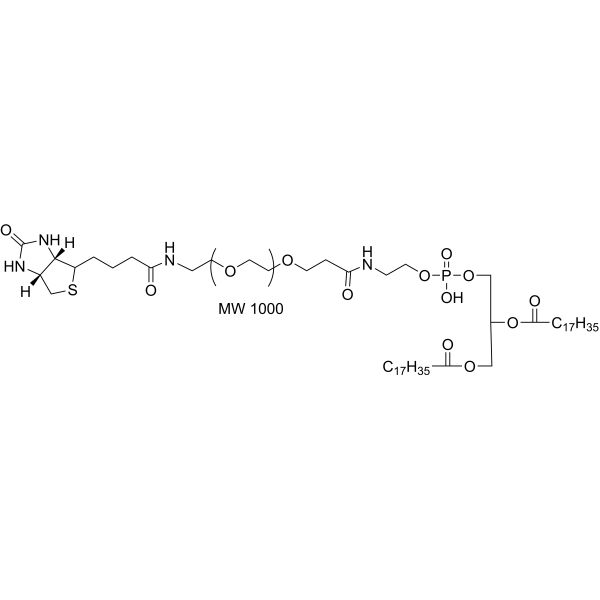
-
- HY-147207B
-
|
|
Liposome
|
Others
|
|
Phospholipid-PEG-Biotin (MW 3400) is a phospholipid PEG derivative that has a biotin and a phospholipid bridged by a linear PEG linker. Phospholipid-PEG-Biotin (MW 3400) can interact with avidinylated antibodies. Phospholipid-PEG-Biotin (MW 3400) can be used to modify liposome and cells surface, and pancreatic islets for cell transplantation .
|
-
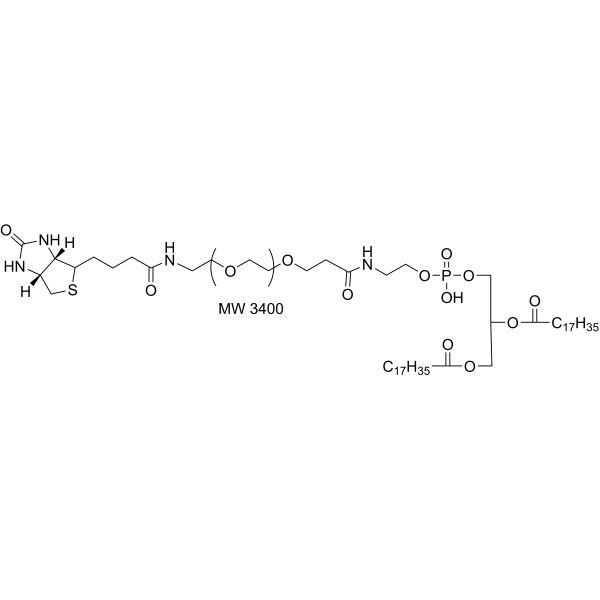
-
- HY-147207D
-
|
|
Liposome
|
Others
|
|
Phospholipid-PEG-Biotin (MW 10000) is a phospholipid PEG derivative that has a biotin and a phospholipid bridged by a linear PEG linker. Phospholipid-PEG-Biotin (MW 3400) can interact with avidinylated antibodies. Phospholipid-PEG-Biotin (MW 3400) can be used to modify liposome and cells surface, and pancreatic islets for cell transplantation .
|
-
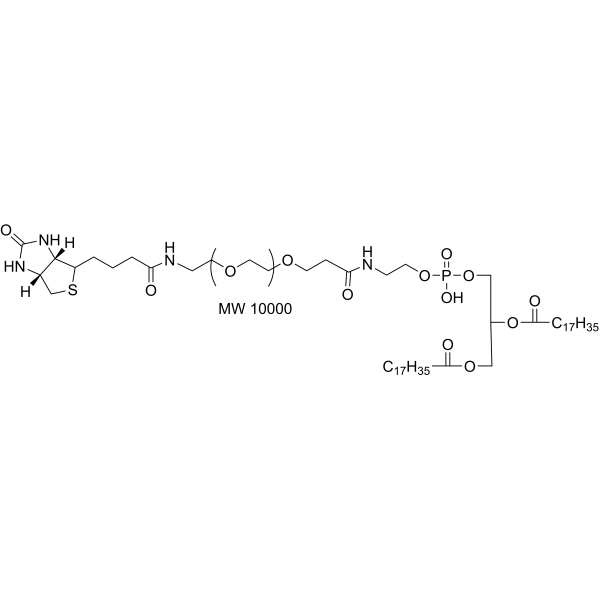
-
- HY-147207E
-
|
|
Liposome
|
Others
|
|
Phospholipid-PEG-Biotin (MW 20000) is a phospholipid PEG derivative that has a biotin and a phospholipid bridged by a linear PEG linker. Phospholipid-PEG-Biotin (MW 3400) can interact with avidinylated antibodies. Phospholipid-PEG-Biotin (MW 3400) can be used to modify liposome and cells surface, and pancreatic islets for cell transplantation .
|
-

-
- HY-154801
-
|
|
Others
|
Others
|
|
Biotin-PEG3-CONH-Ph-CF3-diazirine is a biotin labeled PEG3 derivative. Biotin-PEG3-CONH-Ph-CF3-diazirine can be used for protein labeling .
|
-
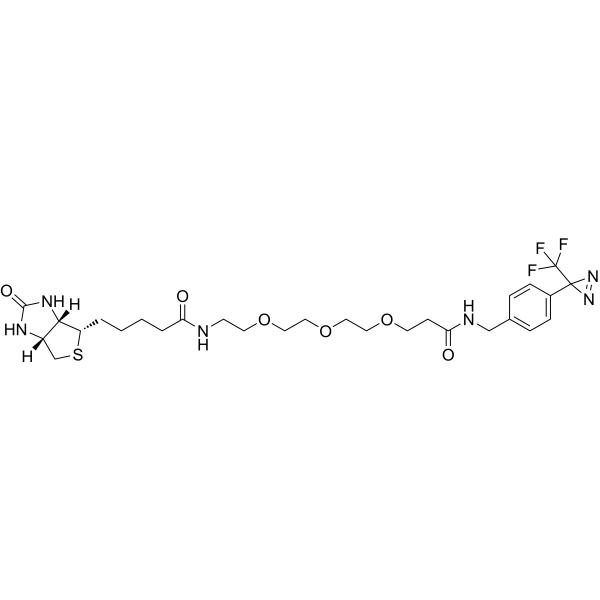
-
- HY-D1919
-
|
|
Fluorescent Dye
|
Others
|
|
ATTO 390 amine is a biotin derivative of ATTO 390 with maximum excitation/emission wavelengths: 390/476 nm.
|
-

-
- HY-D1870
-
|
|
Fluorescent Dye
|
Others
|
|
Sulfo-Cy3-PEG3-biotin potassium is a biotin-modified derivative of Cy3 (Cyanine3) (HY-D0822) dye containing a TCO group. The TCO group of Sulfo-Cy3-PEG3-biotin potassium reacts with the tetrazine functional group in highly specific click chemistry to form a covalent bond. Thus, Sulfo-Cy3-PEG3-biotin potassium can be covalently bound to some biomolecules (especially antibodies, proteins, etc.) to track their location and dynamic changes in biological samples. And because it is labeled with biotin, it is often used in affinity chromatography experiments, such as immunoprecipitation.
|
-

-
- HY-147206A
-
|
|
Fluorescent Dye
|
Others
|
|
Biotin-PEG-Alk (MW 1000) is a biotin labeled PEG derivative. Biotin is an enzyme co-factor, can be used for labeling protein; PEG is a hydrophilic and water-soluble polymer with low toxicity; Alk (Alkyne), acyclic (branched or unbranched) aliphatic hydrocarbon, can react with azido, which improve the efficiency of biotin binding targets. Biotin-PEG-Alk (MW 1000) is a click chemistry reagent, itcontains an Alkyne group and can undergo copper-catalyzed azide-alkyne cycloaddition (CuAAc) with molecules containing Azide groups.
|
-
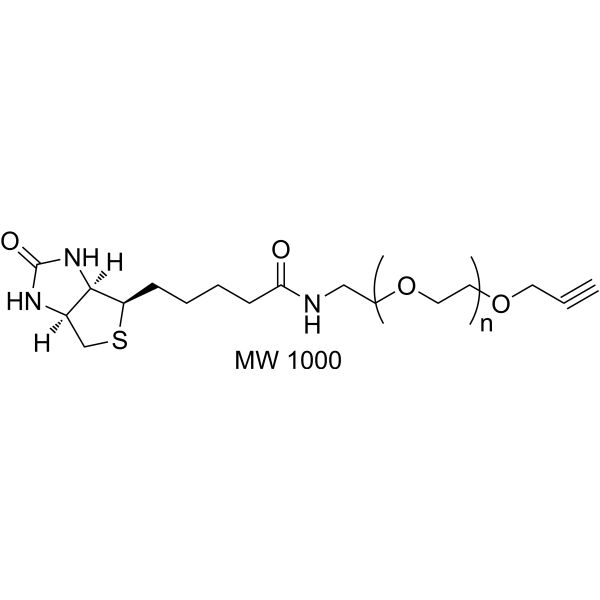
-
- HY-147206B
-
|
|
Fluorescent Dye
|
Others
|
|
Biotin-PEG-Alk (MW 2000) is a biotin labeled PEG derivative. Biotin is an enzyme co-factor, can be used for labeling protein; PEG is a hydrophilic and water-soluble polymer with low toxicity; Alk (Alkyne), acyclic (branched or unbranched) aliphatic hydrocarbon, can react with azido, which improve the efficiency of biotin binding targets. Biotin-PEG-Alk (MW 2000) is a click chemistry reagent, itcontains an Alkyne group and can undergo copper-catalyzed azide-alkyne cycloaddition (CuAAc) with molecules containing Azide groups.
|
-
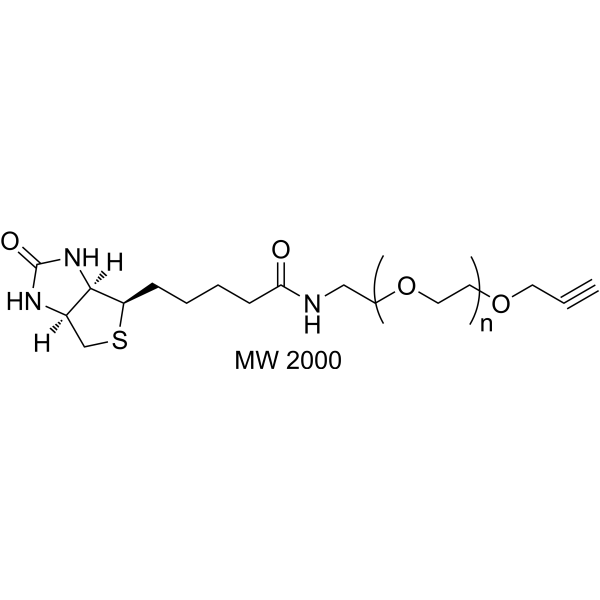
-
- HY-147206C
-
|
|
Fluorescent Dye
|
Others
|
|
Biotin-PEG-Alk (MW 3400) is a biotin labeled PEG derivative. Biotin is an enzyme co-factor, can be used for labeling protein; PEG is a hydrophilic and water-soluble polymer with low toxicity; Alk (Alkyne), acyclic (branched or unbranched) aliphatic hydrocarbon, can react with azido, which improve the efficiency of biotin binding targets. Biotin-PEG-Alk (MW 3400) is a click chemistry reagent, itcontains an Alkyne group and can undergo copper-catalyzed azide-alkyne cycloaddition (CuAAc) with molecules containing Azide groups.
|
-
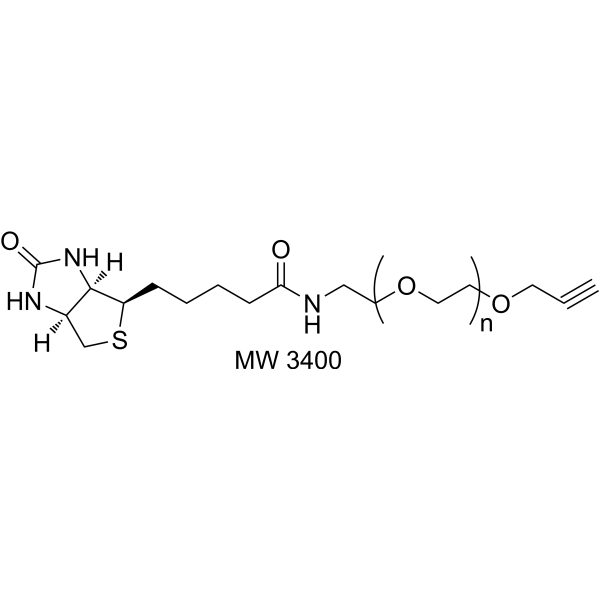
-
- HY-147206E
-
|
|
Fluorescent Dye
|
Others
|
|
Biotin-PEG-Alk (MW 10000) is a biotin labeled PEG derivative. Biotin is an enzyme co-factor, can be used for labeling protein; PEG is a hydrophilic and water-soluble polymer with low toxicity; Alk (Alkyne), acyclic (branched or unbranched) aliphatic hydrocarbon, can react with azido, which improve the efficiency of biotin binding targets. Biotin-PEG-Alk (MW 10000) is a click chemistry reagent, itcontains an Alkyne group and can undergo copper-catalyzed azide-alkyne cycloaddition (CuAAc) with molecules containing Azide groups.
|
-
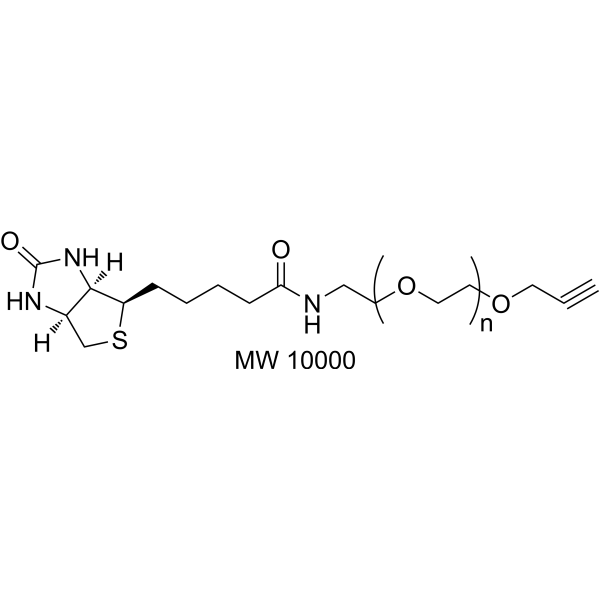
-
- HY-147206F
-
|
|
Fluorescent Dye
|
Others
|
|
Biotin-PEG-Alk (MW 20000) is a biotin labeled PEG derivative. Biotin is an enzyme co-factor, can be used for labeling protein; PEG is a hydrophilic and water-soluble polymer with low toxicity; Alk (Alkyne), acyclic (branched or unbranched) aliphatic hydrocarbon, can react with azido, which improve the efficiency of biotin binding targets. Biotin-PEG-Alk (MW 20000) is a click chemistry reagent, itcontains an Alkyne group and can undergo copper-catalyzed azide-alkyne cycloaddition (CuAAc) with molecules containing Azide groups.
|
-

-
- HY-N11200
-
|
|
Endogenous Metabolite
|
Metabolic Disease
|
|
3-Hydroxyisovalerylcarnitine is a carnitine derivative. 3-Hydroxyisovaleryl carnitine in plasma may serve as a novel biomarker of biotin deficiency in humans, with its concentration increasing with biotin deficiency. Biotin deficiency reduces the activity of biotin-dependent 3-methylcrotonyl-CoA carboxylase, hinders the conversion of 3-methylcrotonyl-CoA into 3-methylglutaconyl-CoA, and impairs the leucine catabolism pathway; resulting in plasma 3-Hydroxyisovalerylcarnitine concentrations rise .
|
-

-
- HY-147207A
-
|
|
Liposome
|
Others
|
|
Phospholipid-PEG-Biotin (MW 2000) is a Biotin labeled phospholipid PEG derivative, can be used for modify liposome and cells surface, and pancreatic islets for cell transplantation. Phospholipid is a class of lipid containing a hydrophilic “head” and two hydrophobic “tails”; PEG is a hydrophilic and water-soluble polymer with low toxicity; Biotin is an enzyme co-factor, can be used for labeling protein .
|
-
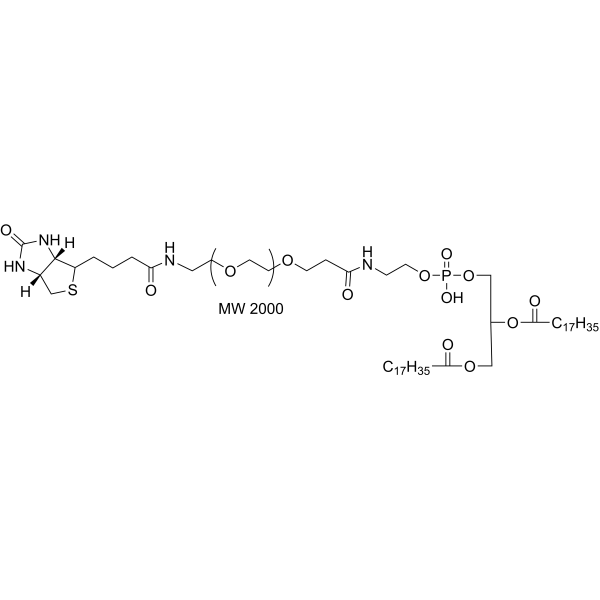
-
- HY-153846
-
|
|
Others
|
Others
|
|
RNA Aptamer Mango Ⅰ (sodium) consists of 39 nucleotides and has an exceptionally high affinity to TO1-biotin (a thiazole orange derivative fluorophore). RNA Aptamer Mango Ⅰ (sodium) can be used to visualize RNA expression or localization in live cells.
|
-

-
- HY-140877
-
|
|
Fluorescent Dye
|
Others
|
|
Dde Biotin-PEG4-TAMRA-PEG4 Alkyne is a dye derivative of TAMRA (HY-135640) modified with a cleavable biotin group. Dde Biotin-PEG4-TAMRA-PEG4 Alkyne contains Alkyne groups that can undergo copper-catalyzed azide-alkyne cycloaddition (CuAAc) with molecules containing Azide groups.
|
-
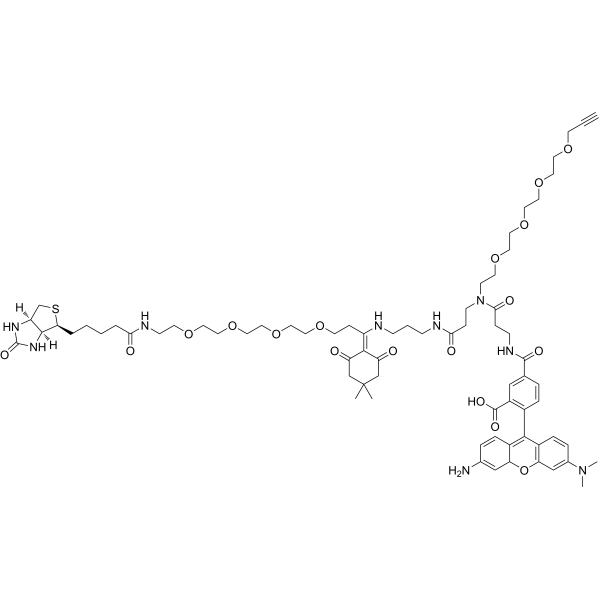
-
- HY-156882
-
|
|
Others
|
Cancer
|
|
Biotin-PEG3-amide-C2-CO-Halofuginone, a kind halofuginone derivative, can be used in the cancer study .
|
-
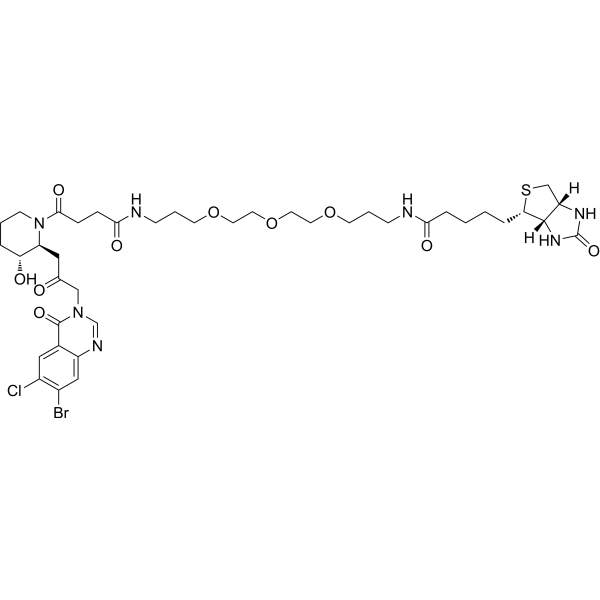
-
- HY-147207C
-
|
|
Liposome
|
Others
|
|
Phospholipid-PEG-Biotin (MW 5000) is a phospholipid PEG derivative, can be used for modify liposome and cells surface, and pancreatic islets for cell transplantation. Phospholipid is a class of lipid containing a hydrophilic “head” and two hydrophobic “tails”; PEG is a hydrophilic and water-soluble polymer with low toxicity; Biotin is an enzyme co-factor, can be used for labeling protein .
|
-
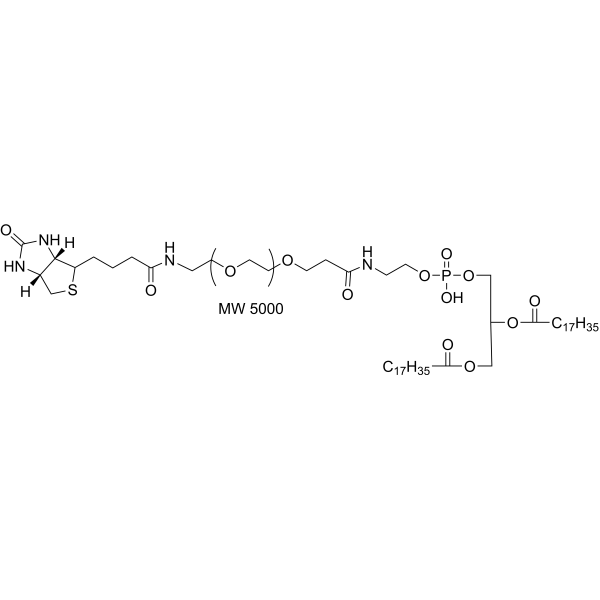
-
- HY-153847
-
|
|
Others
|
Others
|
|
RNA Aptamer Mango Ⅱ (sodium) has an exceptionally high affinity to TO1-biotin (a thiazole orange derivative fluorophore), and can be used to visualize RNA expression or localization in live cells. Compared to the original Mango I aptamer, RNA Aptamer Mango Ⅱ (sodium) has markedly improved fluorescent properties, binding affinities, and salt dependencies.
|
-
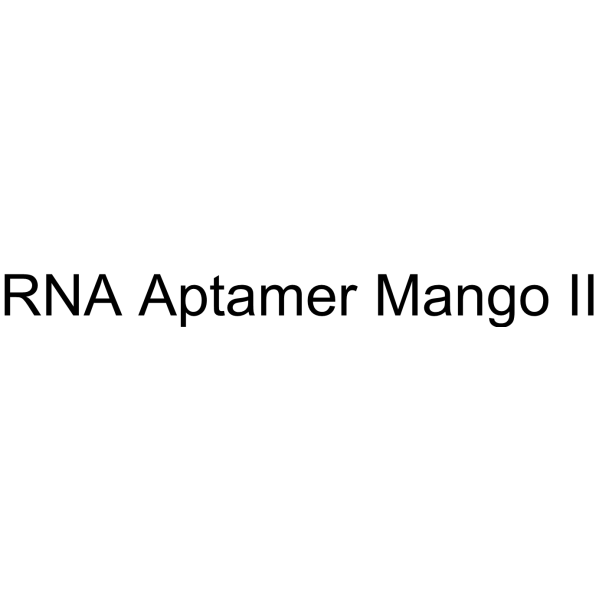
-
- HY-153848
-
|
|
Others
|
Others
|
|
RNA Aptamer Mango Ⅳ (sodium) has an exceptionally high affinity to TO1-biotin (a thiazole orange derivative fluorophore), and can be used to visualize RNA expression or localization in live cells. Compared to the original Mango I aptamer, RNA Aptamer Mango Ⅳ has markedly improved fluorescent properties, binding affinities, and salt dependencies.
|
-
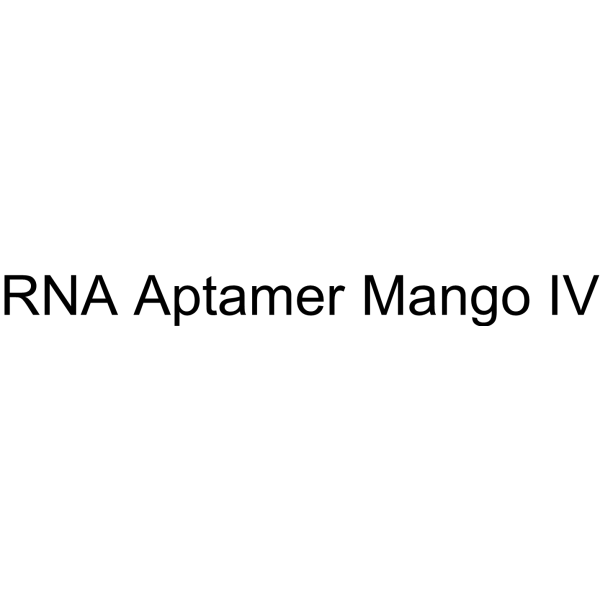
-
- HY-153849
-
|
|
Others
|
Others
|
|
RNA Aptamer Mango Ⅲ (sodium) has an exceptionally high affinity to TO1-biotin (a thiazole orange derivative fluorophore), and can be used to visualize RNA expression or localization in live cells. Compared to the original Mango I aptamer, RNA Aptamer Mango Ⅲ has markedly improved fluorescent properties, binding affinities, and salt dependencies.
|
-
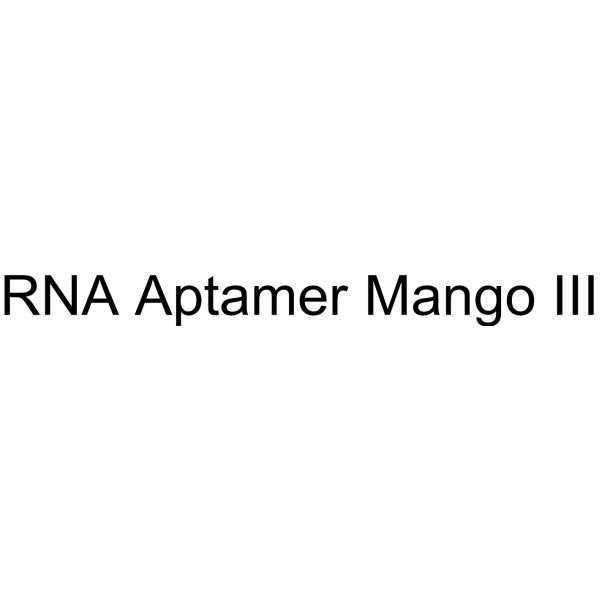
-
- HY-140947
-
|
|
Fluorescent Dye
|
Others
|
|
TAMRA-Azide-PEG-biotin is a dye derivative of TAMRA (HY-135640). TAMRA-Azide-PEG-biotin contains an Azide group and can undergo copper-catalyzed azide-alkyne cycloaddition reaction (CuAAc) with molecules containing Alkyne groups. Strain-promoted alkyne-azide cycloaddition (SPAAC) can also occur with molecules containing DBCO or BCN groups.
|
-
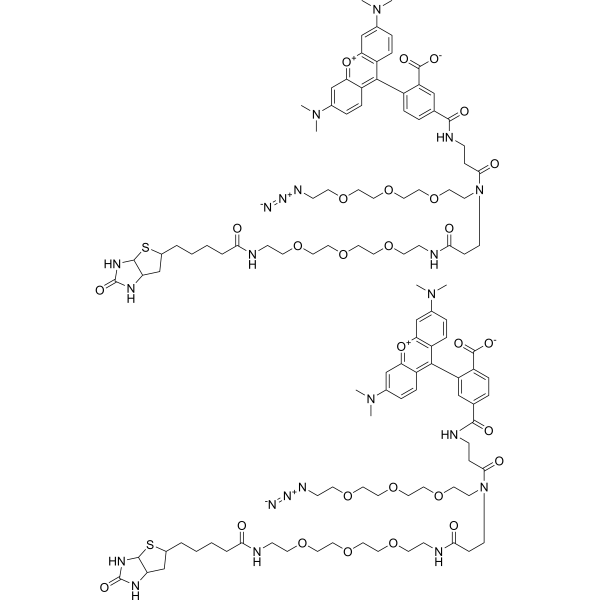
- HY-141091
-
|
|
Fluorescent Dye
|
Others
|
|
Biotin-PEG4-Dde-TAMRA-PEG3-Azide is a dye derivative of TAMRA (HY-135640) modified with a cleavable biotin group. Biotin-PEG4-Dde-TAMRA-PEG3-Azide contains an Azide group and can undergo copper-catalyzed azide-alkyne cycloaddition reaction (CuAAc) with molecules containing Alkyne groups. Strain-promoted alkyne-azide cycloaddition (SPAAC) can also occur with molecules containing DBCO or BCN groups.
|
-
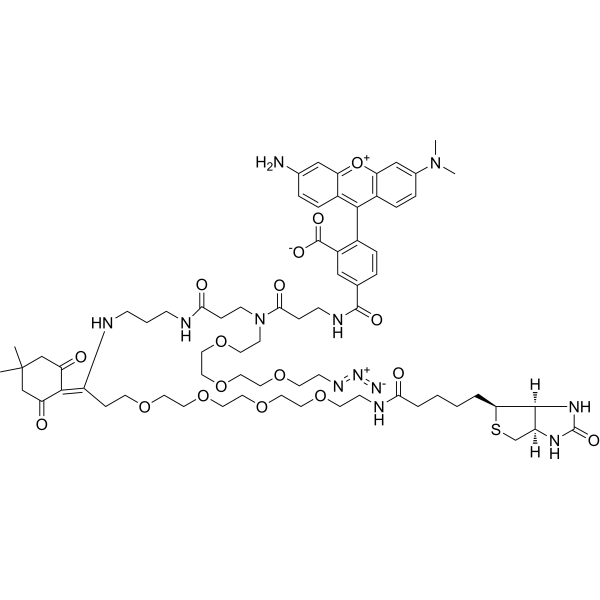
- HY-125658
-
|
|
Others
|
Others
|
|
Biotinyl tyramide is a biotin derivative used for tyramide signal amplification (TSA), as a reagent to amplify both immunohistochemical signals and in situ hybridization protocols. Biotinyl tyramide can be used for the research of tyramide signal amplification .
|
-

- HY-145667
-
|
biotin-JQ1
|
Epigenetic Reader Domain
|
Cancer
|
|
Biotinylated-JQ1 (Biotin-JQ1) is a biotinylated derivative of JQ1 with high affinity for the bromodomain of BRD4. Biotinylated-JQ1 inhibits MM1.S multiple myeloma cells proliferation with the EC50 of 0.4 μM .
|
-

- HY-153797
-
-

| Cat. No. |
Product Name |
Type |
-
- HY-D1695
-
-
- HY-D1938
-
|
|
Fluorescent Dyes/Probes
|
|
ATTO 465 Biotin is a biotin derivative of ATTO 465 with maximum excitation/emission wavelengths: 453/506 nm.
|
-
- HY-D1942
-
|
|
Fluorescent Dyes/Probes
|
|
ATTO 590 Biotin is a biotin derivative of ATTO 590 with maximum excitation/emission wavelengths: 594/622 nm.
|
-
- HY-D1951
-
|
|
Fluorescent Dyes/Probes
|
|
ATTO 594 Biotin is a biotin derivative of ATTO 594 with maximum excitation/emission wavelengths: 603/626 nm.
|
-
- HY-D1964
-
|
|
Fluorescent Dyes/Probes
|
|
ATTO 633 Biotin is a biotin derivative of ATTO 633 with maximum excitation/emission wavelengths: 630/651 nm.
|
-
- HY-D1965
-
|
|
Fluorescent Dyes/Probes
|
|
ATTO 700 Biotin is a biotin derivative of ATTO 700 with maximum excitation/emission wavelengths: 700/716 nm.
|
-
- HY-D1978
-
|
|
Fluorescent Dyes/Probes
|
|
ATTO 610 Biotin is a biotin derivative of ATTO 610 with maximum excitation/emission wavelengths: 616/633 nm.
|
-
- HY-D1988
-
|
|
Fluorescent Dyes/Probes
|
|
ATTO 620 Biotin is a biotin derivative of ATTO 620 with maximum excitation/emission wavelengths: 620/642 nm.
|
-
- HY-D1989
-
|
|
Fluorescent Dyes/Probes
|
|
ATTO 725 Biotin is a biotin derivative of ATTO 725 with maximum excitation/emission wavelengths: 728/751 nm.
|
-
- HY-D1996
-
|
|
Fluorescent Dyes/Probes
|
|
ATTO 647 Biotin is a biotin derivative of ATTO 647 with maximum excitation/emission wavelengths: 630/651 nm.
|
-
- HY-D2003
-
|
|
Fluorescent Dyes/Probes
|
|
ATTO 565 biotin is a biotin derivative of ATTO 565 with maximum excitation/emission wavelengths: 564/590 nm.
|
-
- HY-D2007
-
|
|
Fluorescent Dyes/Probes
|
|
ATTO 488 biotin is a biotin derivative of ATTO 488 with maximum excitation/emission wavelengths: 500/520 nm.
|
-
- HY-D2025
-
|
|
Fluorescent Dyes/Probes
|
|
ATTO 550 biotin is a biotin derivative of ATTO 550 with maximum excitation/emission wavelengths: 554/576 nm.
|
-
- HY-D2076
-
|
|
Fluorescent Dyes/Probes
|
|
ATTO 740 biotin is a biotin derivative of ATTO 740 with maximum excitation/emission wavelengths: 743/763 nm.
|
-
- HY-D2031
-
|
|
Fluorescent Dyes/Probes
|
|
ATTO 514 biotin is a biotin derivative of ATTO 514 with maximum excitation/emission wavelengths: 511/531 nm.
|
-
- HY-D2049
-
|
|
Fluorescent Dyes/Probes
|
|
ATTO 532 biotin is a biotin derivative of ATTO 532 with maximum excitation/emission wavelengths: 532/552 nm.
|
-
- HY-D1911
-
|
|
Fluorescent Dyes/Probes
|
|
ATTO 665 Biotin is a biotin derivative of ATTO 665 with maximum excitation/emission wavelengths: 663/680 nm.
|
-
- HY-D2065
-
|
|
Fluorescent Dyes/Probes
|
|
ATTO 680 biotin is a biotin derivative of ATTO 680 with maximum excitation/emission wavelengths: 681/698 nm.
|
-
- HY-D1923
-
|
|
Fluorescent Dyes/Probes
|
|
ATTO 390 biotin is a biotin derivative of ATTO 390, used for streptavidin reaction, maximum excitation/emission wavelength: 390/476 nm.
|
-
- HY-D1927
-
|
|
Fluorescent Dyes/Probes
|
|
ATTO 425 Biotin is a biotin derivative of ATTO 425, used for streptavidin reaction, the maximum excitation emission wavelength: 439/489 nm.
|
-
- HY-D1919
-
|
|
Fluorescent Dyes/Probes
|
|
ATTO 390 amine is a biotin derivative of ATTO 390 with maximum excitation/emission wavelengths: 390/476 nm.
|
-
- HY-D1870
-
|
|
Dyes
|
|
Sulfo-Cy3-PEG3-biotin potassium is a biotin-modified derivative of Cy3 (Cyanine3) (HY-D0822) dye containing a TCO group. The TCO group of Sulfo-Cy3-PEG3-biotin potassium reacts with the tetrazine functional group in highly specific click chemistry to form a covalent bond. Thus, Sulfo-Cy3-PEG3-biotin potassium can be covalently bound to some biomolecules (especially antibodies, proteins, etc.) to track their location and dynamic changes in biological samples. And because it is labeled with biotin, it is often used in affinity chromatography experiments, such as immunoprecipitation.
|
| Cat. No. |
Product Name |
Type |
-
- HY-156145
-
-
- HY-147207
-
|
|
Drug Delivery
|
|
Phospholipid-PEG-Biotin (MW 1000) is a phospholipid PEG derivative that has a biotin and a phospholipid bridged by a linear PEG linker. Phospholipid-PEG-Biotin (MW 3400) can interact with avidinylated antibodies. Phospholipid-PEG-Biotin (MW 3400) can be used to modify liposome and cells surface, and pancreatic islets for cell transplantation .
|
-
- HY-147207B
-
|
|
Drug Delivery
|
|
Phospholipid-PEG-Biotin (MW 3400) is a phospholipid PEG derivative that has a biotin and a phospholipid bridged by a linear PEG linker. Phospholipid-PEG-Biotin (MW 3400) can interact with avidinylated antibodies. Phospholipid-PEG-Biotin (MW 3400) can be used to modify liposome and cells surface, and pancreatic islets for cell transplantation .
|
-
- HY-147207D
-
|
|
Drug Delivery
|
|
Phospholipid-PEG-Biotin (MW 10000) is a phospholipid PEG derivative that has a biotin and a phospholipid bridged by a linear PEG linker. Phospholipid-PEG-Biotin (MW 3400) can interact with avidinylated antibodies. Phospholipid-PEG-Biotin (MW 3400) can be used to modify liposome and cells surface, and pancreatic islets for cell transplantation .
|
-
- HY-147207E
-
|
|
Drug Delivery
|
|
Phospholipid-PEG-Biotin (MW 20000) is a phospholipid PEG derivative that has a biotin and a phospholipid bridged by a linear PEG linker. Phospholipid-PEG-Biotin (MW 3400) can interact with avidinylated antibodies. Phospholipid-PEG-Biotin (MW 3400) can be used to modify liposome and cells surface, and pancreatic islets for cell transplantation .
|
-
- HY-156144
-
|
DBB chloride
|
Gene Sequencing and Synthesis
|
|
p-Diazobenzoyl-biocytin chloride is a biotin derivative that can be used for the labeling of tyrosine and histidines in peptides and proteins .
|
-
- HY-156146
-
-
- HY-147207A
-
|
|
Drug Delivery
|
|
Phospholipid-PEG-Biotin (MW 2000) is a Biotin labeled phospholipid PEG derivative, can be used for modify liposome and cells surface, and pancreatic islets for cell transplantation. Phospholipid is a class of lipid containing a hydrophilic “head” and two hydrophobic “tails”; PEG is a hydrophilic and water-soluble polymer with low toxicity; Biotin is an enzyme co-factor, can be used for labeling protein .
|
-
- HY-147207C
-
|
|
Drug Delivery
|
|
Phospholipid-PEG-Biotin (MW 5000) is a phospholipid PEG derivative, can be used for modify liposome and cells surface, and pancreatic islets for cell transplantation. Phospholipid is a class of lipid containing a hydrophilic “head” and two hydrophobic “tails”; PEG is a hydrophilic and water-soluble polymer with low toxicity; Biotin is an enzyme co-factor, can be used for labeling protein .
|
| Cat. No. |
Product Name |
Target |
Research Area |
| Cat. No. |
Product Name |
Category |
Target |
Chemical Structure |
-
- HY-128699
-
-

-
- HY-N11200
-
|
|
Structural Classification
Natural Products
Microorganisms
Source classification
|
Endogenous Metabolite
|
|
3-Hydroxyisovalerylcarnitine is a carnitine derivative. 3-Hydroxyisovaleryl carnitine in plasma may serve as a novel biomarker of biotin deficiency in humans, with its concentration increasing with biotin deficiency. Biotin deficiency reduces the activity of biotin-dependent 3-methylcrotonyl-CoA carboxylase, hinders the conversion of 3-methylcrotonyl-CoA into 3-methylglutaconyl-CoA, and impairs the leucine catabolism pathway; resulting in plasma 3-Hydroxyisovalerylcarnitine concentrations rise .
|
-

| Cat. No. |
Product Name |
|
Classification |
-
- HY-130809
-
|
|
|
DBCO
|
|
DBCO-PEG4-Biotin is an azadibenzocyclooctyne-biotin derivative containing a biotin group and 4 PEGs. DBCO-PEG4-Biotin is a versatile biotinylation reagent used for the introduction of a biotin moiety to azide-labeled biomolecules via copper-free strain-promoted alkyne-azide click chemistry (SPAAC) reaction . DBCO-PEG4-Biotin is a click chemistry reagent, it contains a DBCO group that can undergo strain-promoted alkyne-azide cycloaddition (SPAAC) with molecules containing Azide groups.
|
-
- HY-151714
-
|
|
|
Tetrazine
|
|
Biotin-MeTz shiyi is a click chemistry reagent with a terminal methyltetrazine group. Biotin-MeTz shiyi, as a biotin derivative, can be used for the preparation of biotinylated conjugates .
|
-
- HY-147206A
-
|
|
|
Alkynes
|
|
Biotin-PEG-Alk (MW 1000) is a biotin labeled PEG derivative. Biotin is an enzyme co-factor, can be used for labeling protein; PEG is a hydrophilic and water-soluble polymer with low toxicity; Alk (Alkyne), acyclic (branched or unbranched) aliphatic hydrocarbon, can react with azido, which improve the efficiency of biotin binding targets. Biotin-PEG-Alk (MW 1000) is a click chemistry reagent, itcontains an Alkyne group and can undergo copper-catalyzed azide-alkyne cycloaddition (CuAAc) with molecules containing Azide groups.
|
-
- HY-147206B
-
|
|
|
Alkynes
|
|
Biotin-PEG-Alk (MW 2000) is a biotin labeled PEG derivative. Biotin is an enzyme co-factor, can be used for labeling protein; PEG is a hydrophilic and water-soluble polymer with low toxicity; Alk (Alkyne), acyclic (branched or unbranched) aliphatic hydrocarbon, can react with azido, which improve the efficiency of biotin binding targets. Biotin-PEG-Alk (MW 2000) is a click chemistry reagent, itcontains an Alkyne group and can undergo copper-catalyzed azide-alkyne cycloaddition (CuAAc) with molecules containing Azide groups.
|
-
- HY-147206C
-
|
|
|
Alkynes
|
|
Biotin-PEG-Alk (MW 3400) is a biotin labeled PEG derivative. Biotin is an enzyme co-factor, can be used for labeling protein; PEG is a hydrophilic and water-soluble polymer with low toxicity; Alk (Alkyne), acyclic (branched or unbranched) aliphatic hydrocarbon, can react with azido, which improve the efficiency of biotin binding targets. Biotin-PEG-Alk (MW 3400) is a click chemistry reagent, itcontains an Alkyne group and can undergo copper-catalyzed azide-alkyne cycloaddition (CuAAc) with molecules containing Azide groups.
|
-
- HY-147206E
-
|
|
|
Alkynes
|
|
Biotin-PEG-Alk (MW 10000) is a biotin labeled PEG derivative. Biotin is an enzyme co-factor, can be used for labeling protein; PEG is a hydrophilic and water-soluble polymer with low toxicity; Alk (Alkyne), acyclic (branched or unbranched) aliphatic hydrocarbon, can react with azido, which improve the efficiency of biotin binding targets. Biotin-PEG-Alk (MW 10000) is a click chemistry reagent, itcontains an Alkyne group and can undergo copper-catalyzed azide-alkyne cycloaddition (CuAAc) with molecules containing Azide groups.
|
-
- HY-147206F
-
|
|
|
Alkynes
|
|
Biotin-PEG-Alk (MW 20000) is a biotin labeled PEG derivative. Biotin is an enzyme co-factor, can be used for labeling protein; PEG is a hydrophilic and water-soluble polymer with low toxicity; Alk (Alkyne), acyclic (branched or unbranched) aliphatic hydrocarbon, can react with azido, which improve the efficiency of biotin binding targets. Biotin-PEG-Alk (MW 20000) is a click chemistry reagent, itcontains an Alkyne group and can undergo copper-catalyzed azide-alkyne cycloaddition (CuAAc) with molecules containing Azide groups.
|
-
- HY-140877
-
|
|
|
Alkynes
PROTAC Synthesis
|
|
Dde Biotin-PEG4-TAMRA-PEG4 Alkyne is a dye derivative of TAMRA (HY-135640) modified with a cleavable biotin group. Dde Biotin-PEG4-TAMRA-PEG4 Alkyne contains Alkyne groups that can undergo copper-catalyzed azide-alkyne cycloaddition (CuAAc) with molecules containing Azide groups.
|
-
- HY-140947
-
|
|
|
PROTAC Synthesis
Azide
|
|
TAMRA-Azide-PEG-biotin is a dye derivative of TAMRA (HY-135640). TAMRA-Azide-PEG-biotin contains an Azide group and can undergo copper-catalyzed azide-alkyne cycloaddition reaction (CuAAc) with molecules containing Alkyne groups. Strain-promoted alkyne-azide cycloaddition (SPAAC) can also occur with molecules containing DBCO or BCN groups.
|
-
- HY-141091
-
|
|
|
Azide
ADC Synthesis
|
|
Biotin-PEG4-Dde-TAMRA-PEG3-Azide is a dye derivative of TAMRA (HY-135640) modified with a cleavable biotin group. Biotin-PEG4-Dde-TAMRA-PEG3-Azide contains an Azide group and can undergo copper-catalyzed azide-alkyne cycloaddition reaction (CuAAc) with molecules containing Alkyne groups. Strain-promoted alkyne-azide cycloaddition (SPAAC) can also occur with molecules containing DBCO or BCN groups.
|
Your information is safe with us. * Required Fields.
Inquiry Information
- Product Name:
- Cat. No.:
- Quantity:
- MCE Japan Authorized Agent:






























































